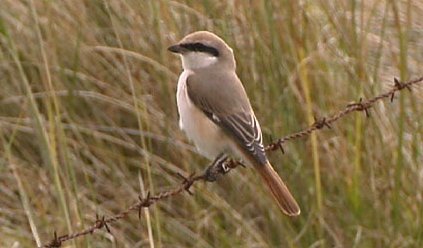
On Sunday 1 October 2000 on the western tip of Vlieland and isabelline shrike species Lanius isabellinus/phoenicuroides/arenarius was seen by 14 birders on their way back to Texel. Darkness felt and the bird could therefore not be relocated. Next day - Monday 2 October - however, is was redicovered by Harmjan Wight on Texel, the neighbouring island. There he (it was a male) stayed till Friday 6 October and was seen by numerous visiting birdwatchers. If accepted, it will be the first record of Turkestan Shrike (Lanius phoenicuroides, formerly known as Lanius isabellinus phoenicuroides). There are 6 records now of isabelline shrike in the Netherlands: 18-19 October 1985 Texel (probably isabellinus, but not accepted after review), 21 October 1993 (most probably isabellinus, but not accepted after review), 4 May 1995 Texel (accepted as isabellinus), 8-11 December 1996 Lauwersoog (accepted as isabellinus), 1-4 October 2000 Castricum (accepted as isabellinus) and 1-6 October Vlieland and Texel (accepted as phoenicuroides) (cf Dutch Birding 22 (5):309 and 319-320, 2000).
Faithful viewers of my homepage have seen that I saw an Isabelline Shrike in 1996, which at that time I thought it was a phoenicuroides. The article by Tim Worfolk (Dutch Birding 22 (6): 323-362, 2000) suggests it is better to identify this as isabellinus because of lack of supercilium, slight orange hue to the cheecks (which is diagnostic) and flanks while the sand-coloured upperparts also point to isabellinus more than phoenicuroides.

6 October 2000, De Cocksdorp, Texel NH; © Leo Boon.

6 October 2000, De Cocksdorp, Texel NH; © René van Rossum.
Note the difference in colours when comparing the two
photographs. In real this was the same: under certain light
conditions this bird looked exactly like the adult male of
Daurian Shrike Lanius isabellinus (formerly speculigerus)
in Shrikes: A Guide to the Shrikes of the World by Norbert
Lefranc & Tim Worfolk, 1997 on plate 3, figure 4e. The first
days of its stay this bird was identified as such, because
identification was more or less based on a draft of the article
without the plates and photographs by Tim Worfolk. When the
excellent article by Tim Worfolk finally appeared in Dutch
Birding (with plates and photographs!), it became more clear this
was a Turkestan Shrike. The broad and contrasting white
supercilium points to Lanius phoenicuroides, the light
base to the bill is not impossible for phoenicuroides
while isabellinus is even more cinnamon coloured on the
underparts, especially on the cheeks. And besides this
identification hassle, I consider this as the most beautiful
rarity I have seen the past 10 years in the Netherlands!
For more details on the occurrence of Isabelline Shrike-taxa in Europe, see Dutch Birding 30 (2): 78-92, 2008.
Do you want to go to the main-index, the 2000-index or the next new species Egyptian Vulture?